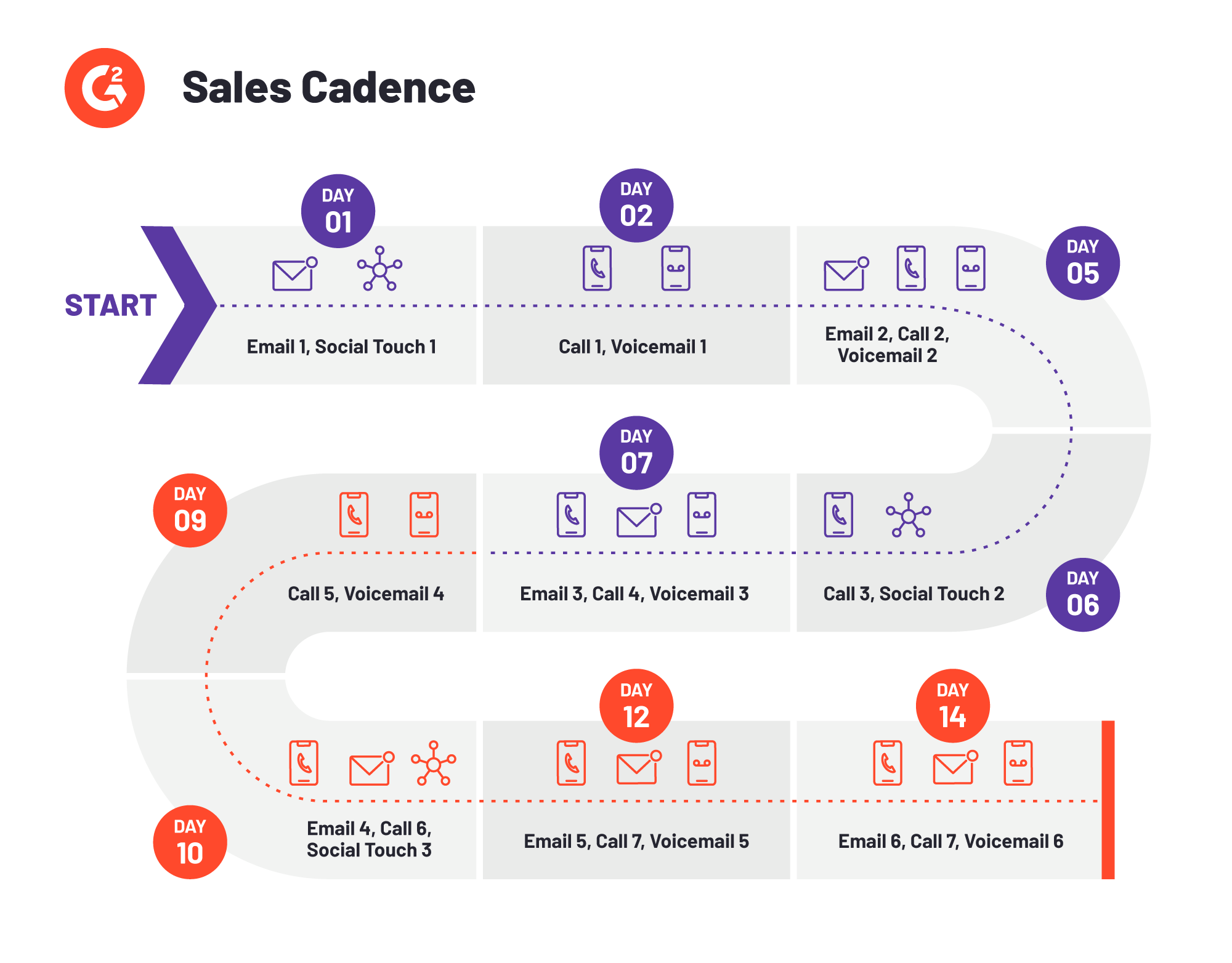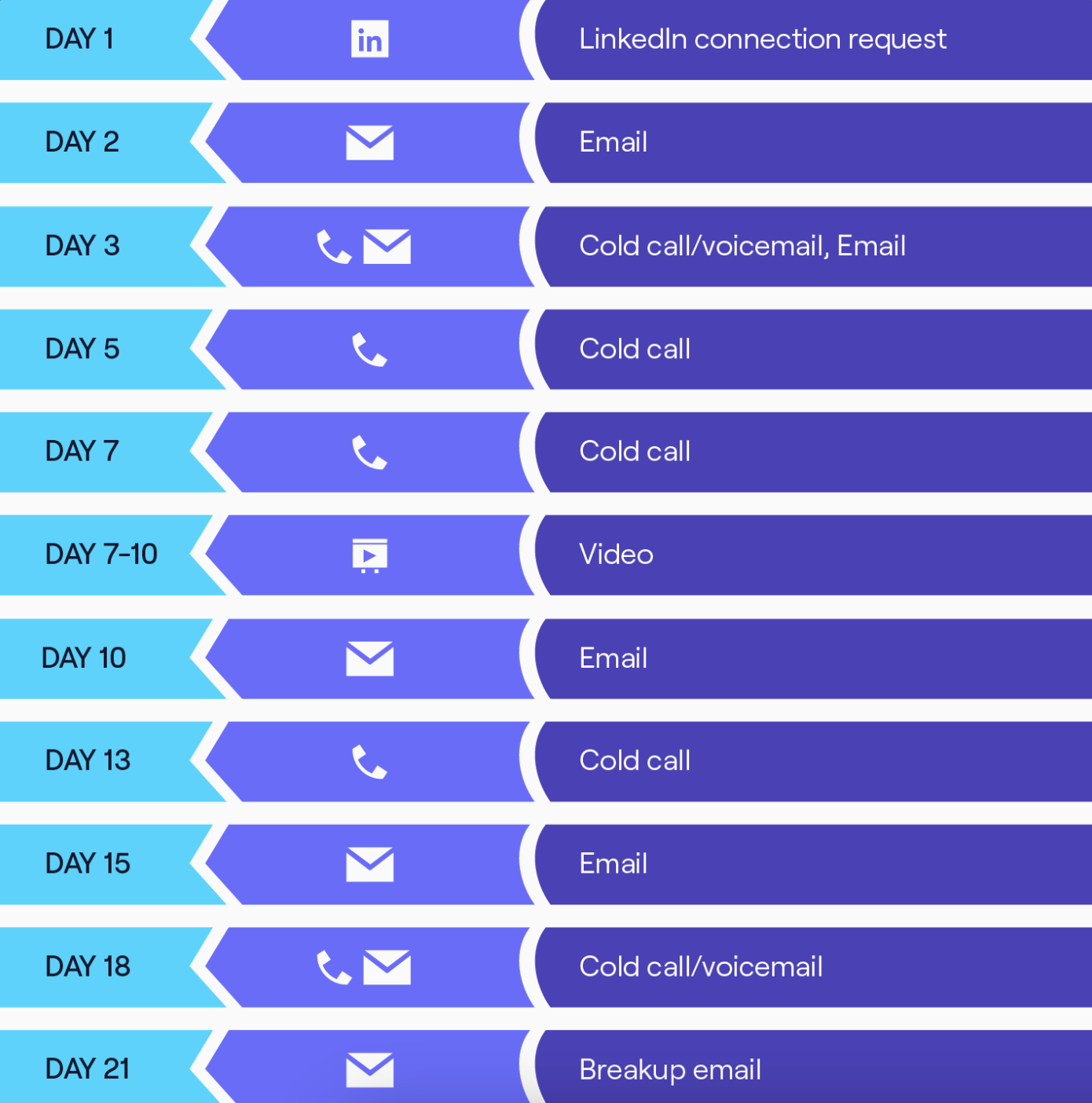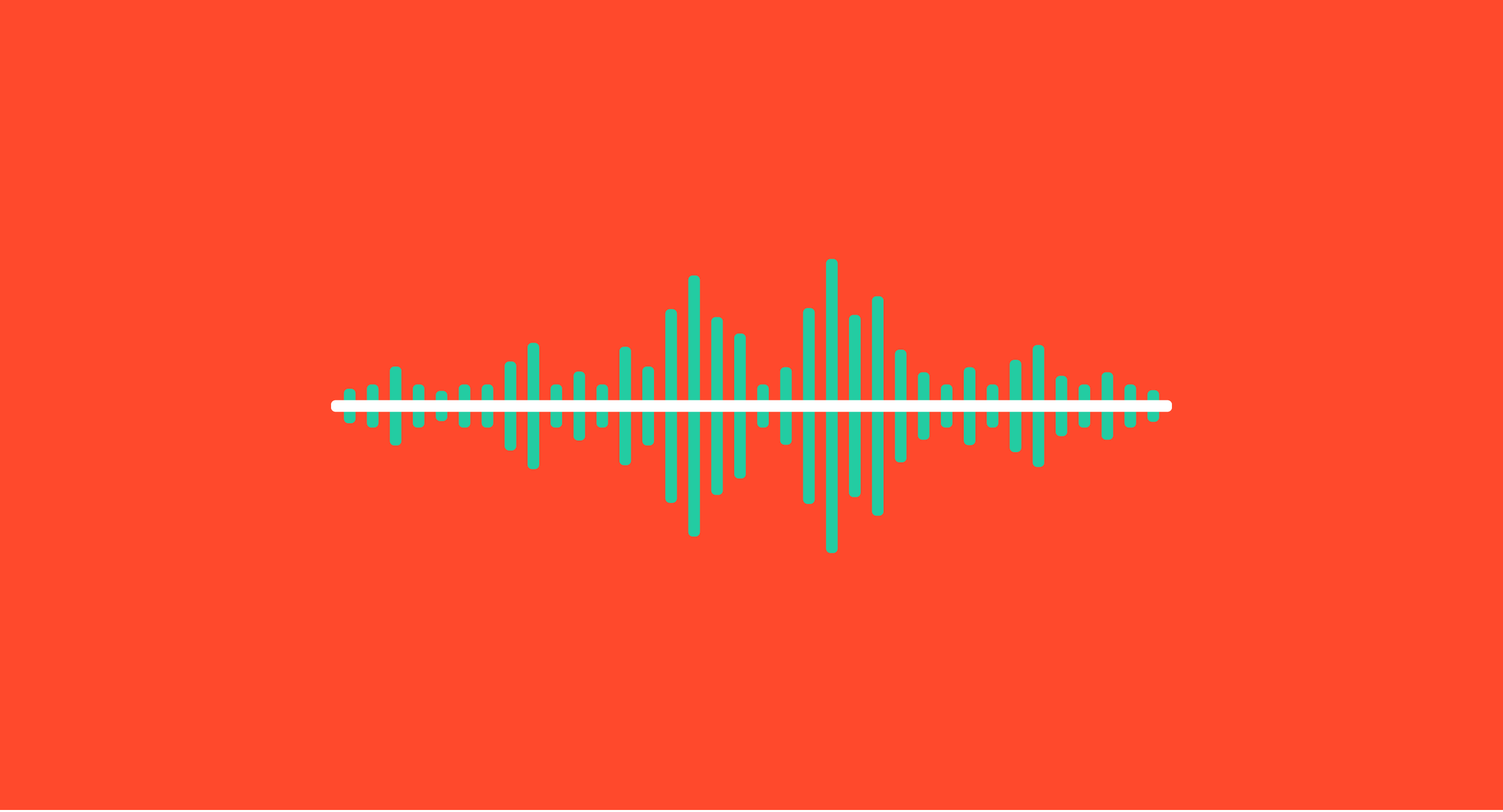When distributing fresh leads to a sales team, you wouldn’t want to give reps a list of valuable prospects’ contact information and say go nuts.That lack of direction will leave reps with a phone in hand or a cold email ready to be sent, asking themselves if this is the right approach to start prospecting. And if it doesn’t work the first time, where should they go from there?
Sales as a business system and formal process requires structure, organization, a pattern, and a tool like CRM software to follow. Your most revenue-focused department shouldn’t rely on randomness. As new prospects enter the pipeline and reps start their outreach, they should follow a sales cadence.
What is sales cadence?
A sales cadence refers to the actions a salesperson takes to close a deal with a customer. It is usually spread out over a set number of days and includes every attempt to contact a prospect, including phone calls, voicemails, emails, and social media messages.
Your sales cadence is similar to your sales process, except this version includes more details about the actions that sales reps will take along the way.
Offering a framework of your sales process for reps in the form of a sales cadence is extremely helpful. It provides ultimate guidance when deciding on outreach methods, helps reps find their way if things get a bit off track, and presents the opportunity to master the sequence, resulting in reps becoming experts in your business’s sales strategy.
Your reps and business can only feel those positive effects if you have an effective sales cadence. While someone can familiarize themselves with a sales outreach pattern, if it doesn’t make sense for the customer, it won’t matter if they know it like the back of their hand.
A successful sales cadence enters prospects into the sales pipeline, qualifies them for opportunities, and converts them into loyal customers. Any sales cadence that isn’t doing that as efficiently as possible needs to be reevaluated.
If you’re in that situation, don’t worry. The article below will teach you about the elements of a sales cadence, how to build one, and best practices to follow.
5 elements of sales cadence
While your business’ sales cadence will include touchpoints with prospects and customers, there are a few other elements you need to remember along the way as well: timing, frequency of contact, the channels you use, your various audiences, and the content included in those interactions.
Keep in mind that finding the right elements for your business might take some trial and error. What works for one company or sales cycle for a particular solution might be completely wrong for another. The only way to make the following four elements of a sales cadence work for your business is to remain consistent and always evaluate the process.
Timing
When creating a sales cadence schedule for your reps to follow, timing is everything. When thinking about timing, consider it in terms of the day of the week as well as the time of day you reach out to the prospect.
Mondays usually consist of attending meetings and playing catch up from last week, and Fridays include winding down with simple last minute tasks and heading out early. So you can count those two days out for prospecting. That leaves you with Tuesday, Wednesday, and Thursday.
Also keep in mind that you don’t want to reach out to prospects at the beginning of the day, because they are likely mentally processing everything they have to get done. Stay away from lunch time as well, as most people like to venture away from their desk during breaks. Statistically speaking, the best time to reach out to a prospect is between 4-5 p.m.
Frequency
Along the lines of timing, you should also remember to spread out your scheduled touchpoints. The last thing you want is for the prospect to think you’re spamming them with outreach. This is a recipe to be ignored. You don’t want to be written off by a prospect before you even have a chance to interact with them, but you also don’t want them to forget about you.
A general rule of thumb is to start with an email and then follow up with a phone call, leaving a voicemail if they don’t answer. From there, make sure to space out other touchpoints and incorporate a variety of outreach methods. Some prospects might not even pay attention to their LinkedIn messages because they are so consumed with answering emails, so approach them with a few different methods – without overwhelming them.
A typical sales cadence will last anywhere between two and four weeks. If the relationship with the prospect isn’t going anywhere, don’t just lengthen the sales cadence. You want to ensure that every interaction offers fresh content from your end. It’s better to have a shorter cadence with quality information for the prospect than one that is redundant and longer just for the sake of it.
Whatever you do in terms of frequency, make sure you track each of your touchpoints in your CRM system. This way, as you move on to the next step in the cadence, you can easily find information regarding the last interaction and pick up right where you and the prospect left off.
Channel
Another important element of the sales cadence you follow is the channel you decide to use for each touchpoint with the prospect. Your sales cadence will likely include multiple channels for your reps to use.
Again, you won’t know which type of communication method your prospect prefers until they explicitly state it. Going at them from multiple channels might seem scattered, but it’s the only way to pick one to move forward with.
There are three main outreach communication methods that your sales cadence will include: email, phone, and social media.
- Email: You’ll likely start with a cold email, as this outreach method offers the chance to send a more detailed and lengthy message. The rest of your sales cadence, which will include all three methods, should complement everything that you’re sending through email.
- Phone: The outbound calls you make to your prospects will be more concise and to the point than your emails. However, they should follow the same messaging. The same goes for any sales voicemail message that is left.
- Social media: Social media touches will work in tandem with your emails and phone calls. They should be scattered throughout your sales cadence and include things such as likes, comments, and direct messages.
Audience
Building a good sales cadence requires a deep understanding of the audience(s) you are targeting. If your business is new, small, and only offers one solution, it might require one sales cadence to effectively sell to that one group of buyers. However, if you have multiple solutions and sell it to businesses of all sizes, your target audiences might differ, demanding more than one sales cadence to suit each of their preferences.
To create a proper sales cadence for each audience, research all of them to determine their pain points and the platforms in which they are the most active. Once those are established, you can prioritize the groups based on how much value they can offer your business.
Content
Quite arguably the most important element of your sales cadence is the content you are distributing to your prospects throughout the sequence. The timing, frequency, and channels you use for your touchpoints could be planned out to perfection, but if the actual content of the messages you are sending aren’t well suited for that audience (your prospects), then none of that matters.
Across the entire sales cadence, every single interaction and attempt at contacting a prospect you have needs to be focused on information regarding the value that your solution can offer them. Your conversations should include relevant research on the prospect and anything that can help you create a relationship with them.
However, if you ever get lost, returning to the value is never a bad place to steer the conversation back on track.
¿Quieres aprender más sobre Software de CRM? Explora los productos de CRM.
Sales cadence examples
If you’re looking to establish a sales cadence within your business's sales team, here's a solid example of what it might look like.
While not all sales cadences will look identical, the overall idea remains the same: to make consistent, sequential, and methodical touchpoints with prospects in the hopes of converting them into customer. A typical sales cadence will last anywhere between five and 22 days.

Your final draft might not exactly resemble this example. However, the first and last days will usually follow a similar pattern across businesses. Let’s examine those a little further.
On the first day, you’ll want to interact with the prospect’s social media account and send them a cold email. Show them you’ve researched their business and that you have something of value to offer them. The next day, follow that email up with a phone call, and if they don’t answer, leave a voicemail. Make sure the contents of that message reflect what you said in your initial email.
The next couple of touchpoints will likely vary, but on the last day of your sales cadence, if no relationship has been created, you will “break up” with the prospect. This will include your last email and phone call or voicemail.
But don’t get too emotional.
The point of these messages is to wrap up your sales cadence, remind the prospect of a challenge their business is facing, and how your solution can come to the rescue if they give you the chance.
One last time, remind them of all the value they can revel in if they become a customer. Leave the door open for contact in the future, and let them know that you’d love to work with them at some other time. As far as breakups go, it should be pretty positive and upbeat.
Whatever you decide on for your business’s sales cadence, it should always include multiple channels of communication. You never know what the prospect prefers, and using the same method over and over is ineffective for everyone involved. Go at them from all angles with phone, email, and social media.
Second, you need to create a sense of urgency without being annoying. Allow at least one day to pass between each touchpoint, but never wait more than four.
And lastly, your sales cadence should be under constant evaluation. Examining your cadence next to your pipeline will help you pick out which sales activities are converting customers and which ones are causing them to lose interest.
Below is another example of a sales cadence.
 Source: Cognism
Source: Cognism
Why is a sales cadence important?
Businesses will implement a sales cadence to provide reps with structure. As the sales team becomes more familiar with their current cadence, they can pick out inefficiencies and roadblocks they are running into.
Getting in touch with prospects is a huge challenge for reps, and going through the same process a few times and implementing new techniques can help them realize what’s working and where they tend to lose the most prospects.
It also enables reps to be more organized. By creating and offering a systemic framework, they can start their day knowing exactly which actions they need to take and for which prospects.
There is no more guessing what needs to be done and when. If a rep forgets where they left off with a prospect, they can retrace their steps back to the beginning of the sales cadence, see the last interaction, and move forward from there (another important reason to track each customer interaction in your CRM).
Implementing a sales cadence also makes it easier to train new reps as your business grows. You might be able to get away with not having a solid process in place with a few reps and minimal customers, but as your business starts to experience growth in employees and clients, you’ll need to be able to quickly train new reps.
Using a sales cadence will remove any stress associated with showing new salespeople your business's selling approach.
Sales cadence best practices
Follow the best practices below to create a sales cadence that drives engagement, increases conversions, and helps your sales reps close more deals.
- Tailor it to your buyer persona: Understand your ideal customer profile, their challenges, buying habits, and preferred communication channels. Craft a cadence that resonates with their needs.
- Personalize messaging. Avoid generic templates. Use the prospect's name, reference their company, and tailor your message to their specific needs.
- Refine your value proposition. Ensure your message clearly communicates the benefits your product or service offers to buyer persona and how it eases their pain points. Focus on the value you bring, not just your features.
- Test and optimize. Don't be afraid to experiment! Try different cadences with varying touchpoints, content types, and timing. Analyze results to see what resonates best with your audience.
- Be flexible. If a prospect isn't engaging, adjust your approach. Reduce outreach frequency or switch communication channels.
- Automate where possible. Use sales cadence software like CRM to schedule emails, track outreach, and personalize messages at scale. This frees up your reps for high-value interactions.
- Focus on quality over quantity. Lastly, don't bombard your prospects. Prioritize well-crafted, personalized messages over a high volume of generic outreach.
Track your sales cadence success
- Open rate: Track the percentage of emails your prospects actually open.
- Response rate: Measure how many prospects reply to your emails or calls.
- Conversion rate: Identify the percentage of prospects who convert from a specific stage, such as a lead, to the next desired stage, a qualified lead.
- Demo booking rate: Track the percentage of prospects who schedule a product demo after interacting.
- Pipeline progression: Monitor how many prospects move through different stages of your sales pipeline.
- Time to conversion: Measure the average time it takes for a prospect to convert from initial contact to a closed deal.
Follow the yellow brick road
While winging it can sometimes be an effective sales strategy, you don’t want reps to rely on that mentality. Offering a sales cadence shows the team what they can expect when attempting to get a prospect to convert into a customer.
There might be some offbeat conversations and interactions along the way, and that’s totally fine. Let them follow their instincts. However, as a leader, it’s your job to always provide that guiding light.
Plain and simple, a CRM is necessary for your business’ sales cadence to run smoothly. Learn more about what else a CRM can do for your team.
This article was originally published in 2020. It has been updated with new information.

Mary Clare Novak
Mary Clare Novak is a former Content Marketing Specialist at G2 based in Burlington, Vermont, where she is explored topics related to sales and customer relationship management. In her free time, you can find her doing a crossword puzzle, listening to cover bands, or eating fish tacos. (she/her/hers)

